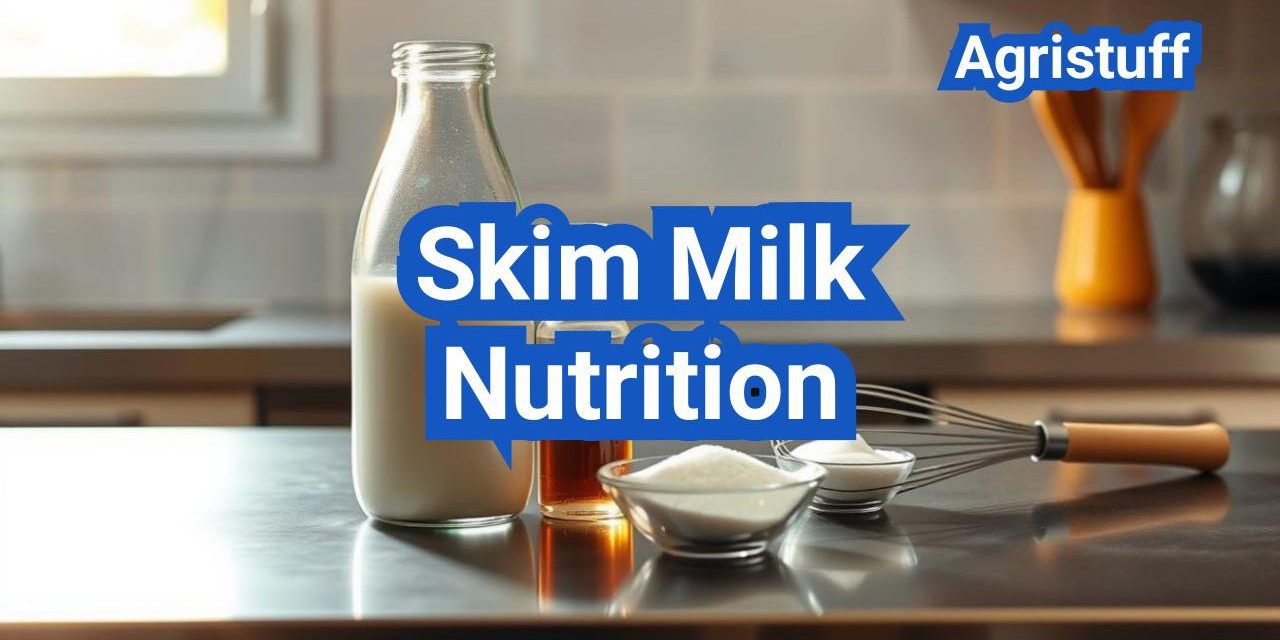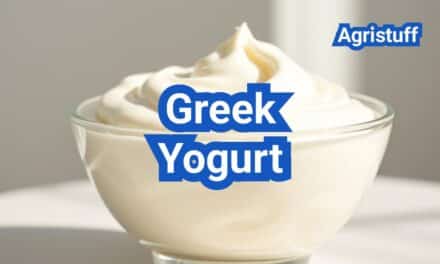This article does not contain medical advice
For those watching their diet, skim milk is a popular choice due to its low calorie and high protein content. A 250ml serving of skim milk contains approximately 90 calories and 9g of protein, making it an excellent option for those seeking to manage their weight without compromising on nutritional value.
The nutritional benefits of skim milk ( Skim Milk Nutrition ) extend beyond just calories and protein. It is also a rich source of calcium, with a 250ml serving providing around 300mg. This makes it a great choice for supporting bone health.
Key Takeaways
- Skim milk is low in calories, with a 250ml serving containing approximately 90 calories.
- It is high in protein, providing about 9g per 250ml serving.
- Skim milk is a good source of calcium, supporting bone health.
- It is a nutritious choice for those managing their weight.
- Skim milk supports overall nutritional well-being.
Understanding Skim Milk: What Makes It Different
With its virtually fat-free composition, skim milk has gained popularity among health-conscious consumers. Skim milk is made by removing the fat from whole milk, resulting in a product that is low in calories and rich in nutrients.
Definition and Production Process | Skim Milk Nutrition
Skim milk, also known as nonfat milk, is produced by skimming the cream off whole milk. This process significantly reduces the fat content, making it an attractive option for those monitoring their fat intake. The production involves centrifuging whole milk to separate the cream, resulting in a milk product that contains less than 1% fat.
The history of skim milk dates back to the 1980s in the U.S., when consumers began paying more attention to dietary fat. Since then, skim milk has become a staple in many health-conscious households.
Fat Content Comparison | Skim Milk Nutrition
When comparing skim milk to whole milk, the most notable difference is the fat content. Whole milk contains approximately 3.5% fat, whereas skim milk contains less than 1% fat. This significant reduction in fat content translates to a lower calorie count in skim milk compared to whole milk.
For those comparing skim milk vs whole milk, the difference in fat content is a crucial factor. Skim milk is ideal for those looking to reduce their dietary fat intake without sacrificing nutritional value.
Common Misconceptions | Skim Milk Nutrition
One common misconception about skim milk is that it lacks flavor or nutritional value compared to whole milk. However, skim milk nutrition facts show that it retains most of the vitamins and minerals found in whole milk, including calcium, vitamin D, and potassium.
Another misconception is that skim milk is overly processed. While it’s true that skim milk undergoes processing to remove fat, it is still considered a natural product and is fortified with vitamins to enhance its nutritional profile.
Skim Milk Nutrition: Complete Breakdown
Delving into the nutritional breakdown of skim milk reveals its potential to support overall health and wellness. Skim milk is a nutrient-rich beverage that offers a range of health benefits when consumed as part of a balanced diet.
Nutritional Value Per 100g | Skim Milk Nutrition
Understanding the nutritional content of skim milk per 100g serving is essential. According to nutritional data, a 100g serving of skim milk contains approximately 34 calories, 3.5g of protein, and 120mg of calcium. It is also a source of vitamins A and D, making it a nutritious choice.
Nutritional Value Per Cup (240ml) | Skim Milk Nutrition
For those who measure their milk consumption in cups, a 240ml cup of skim milk provides a more substantial amount of nutrients. This serving size is commonly used in dietary planning and nutrition labeling. The exact nutritional content can vary slightly by brand due to differences in fortification and processing.
Generally, a cup of skim milk is rich in protein, calcium, and vitamins, supporting bone health and providing essential nutrients.
How to Read a Skim Milk Nutrition Label
Reading a skim milk nutrition label can seem daunting, but it’s straightforward once you know what to look for. Start by checking the serving size, as nutritional values are typically listed per serving. Look for the amounts of calories, protein, calcium, and vitamins A and D. Be aware of any added sugars or fortifications.
- Check the serving size
- Review the calorie and nutrient content
- Be mindful of added ingredients
By understanding how to read a skim milk nutrition label, you can make more informed choices about your dairy consumption.
Caloric Content of Skim Milk
Understanding the caloric content of skim milk is essential for those monitoring their diet. Skim milk, known for its low fat content, is a popular choice among health-conscious individuals. The caloric content can vary based on the serving size, making it crucial to understand the nutritional facts to make informed dietary choices.
Calories in Different Serving Sizes
The caloric content of skim milk is directly related to its serving size. A 250ml serving of skim milk contains approximately 90 calories. To give you a better understanding, here’s a breakdown of the calories in different serving sizes:
| Serving Size | Calories |
|---|---|
| 1 cup (240ml) | 83 |
| 1/2 cup (120ml) | 41.5 |
| 250ml | 90 |
Calorie Comparison with Other Milk Types | Skim Milk Nutrition
Skim milk is often compared to other types of milk in terms of caloric content. Whole milk, for instance, contains around 152 calories per 240ml serving, significantly more than skim milk. Here’s a comparison of the caloric content of different milk types per 240ml serving:
| Milk Type | Calories per 240ml |
|---|---|
| Skim Milk | 83 |
| Whole Milk | 152 |
| Almond Milk (unsweetened) | 30-60 |
How to Track Skim Milk Calories in Your Diet
Tracking the calories from skim milk in your diet involves understanding your overall daily calorie intake and how skim milk fits into it. To effectively track, you can use a food diary or a calorie tracking app. Be sure to measure your skim milk consumption accurately to log the correct number of calories.
For a balanced diet, consider the nutritional benefits of skim milk alongside its caloric content. Skim milk is not only low in calories but also rich in protein, vitamins, and minerals, making it a nutritious addition to a healthy diet.
Protein Power: Skim Milk

Skim milk is not just low in fat; it’s also a rich source of protein. For individuals looking to boost their protein intake, skim milk is an excellent dietary addition.
Protein Content and Quality | Skim Milk Nutrition
Skim milk contains a significant amount of protein. A 250ml serving of skim milk provides approximately 9g of protein, making it a valuable source of this essential nutrient. The protein in skim milk is of high quality, containing all essential amino acids necessary for muscle repair and growth.
How Skim Milk Protein Compares to Other Protein Sources
Compared to other protein sources, skim milk protein is highly bioavailable, meaning it’s easily absorbed by the body. For instance, a cup of skim milk contains a similar amount of protein to a small egg or a tablespoon of peanut butter, making it a convenient protein source.
How to Maximize Protein Benefits from Skim Milk
To maximize the protein benefits from skim milk, consider incorporating it into your daily routine. You can use it in smoothies, as a base for protein shakes, or simply consume it as a beverage. Additionally, choosing fortified skim milk can provide extra protein and nutrients.
Essential Vitamins and Minerals in Skim Milk
Skim milk is an excellent source of several key nutrients, including calcium, vitamin D, and potassium. These nutrients play crucial roles in maintaining overall health, particularly bone health.
Calcium Content and Bone Health | Skim Milk Nutrition
Skim milk is renowned for its high calcium content, a mineral essential for building and maintaining strong bones and teeth. A 250ml serving of skim milk typically contains around 300mg of calcium. This calcium content supports bone health by promoting bone density, reducing the risk of osteoporosis and fractures.
Vitamin D Fortification | Skim Milk Nutrition
Many dairy producers fortify their skim milk with vitamin D, a nutrient that enhances calcium absorption in the body. Vitamin D fortification in skim milk ensures that consumers receive adequate amounts of this vital vitamin, supporting bone health and immune function. A 250ml serving of fortified skim milk usually contains about 2.5µg of vitamin D.
Potassium and Other Minerals | Skim Milk Nutrition
In addition to calcium and vitamin D, skim milk is a good source of potassium, an electrolyte that helps regulate blood pressure and supports overall cardiovascular health. Skim milk may also contain other minerals, albeit in smaller quantities.
How to Ensure You’re Getting Fortified Skim Milk
To reap the nutritional benefits of skim milk, it’s essential to choose products that are fortified with vitamins A and D. Consumers should check the nutrition label to confirm that the skim milk they purchase contains these added nutrients. Opting for lactose-free skim milk is also a viable option for those with lactose intolerance, ensuring that everyone can enjoy the nutritional benefits of skim milk.
Sugar Content in Skim Milk: What You Need to Know

Skim milk naturally contains sugars, but how does it compare to other milk types in terms of sugar content? Understanding the sugar content in skim milk is essential for consumers who are monitoring their sugar intake or making informed dietary choices.
Natural vs. Added Sugars | Skim Milk Nutrition
It’s crucial to differentiate between natural and added sugars when discussing the sugar content in skim milk. Natural sugars are inherent in milk, primarily in the form of lactose, a disaccharide composed of glucose and galactose. Unlike added sugars, which are introduced during processing, natural sugars are not considered detrimental to health in the same way.
Skim milk contains lactose, a natural sugar that provides energy. According to nutritional data, a 250ml serving of skim milk contains approximately 12g of sugars, all of which are naturally occurring lactose.
Lactose Content | Skim Milk Nutrition
Lactose is the primary sugar found in skim milk. The lactose content remains relatively consistent across different types of milk, including skim, whole, and variations in between. However, the overall sugar content can vary slightly based on the milk’s origin, the cow’s diet, and processing methods.
| Milk Type | Lactose Content (g/250ml) |
|---|---|
| Skim Milk | 12g |
| Whole Milk | 12g |
| Lactose-Free Skim Milk | 0g (lactose removed) |
How to Choose Lower Sugar Options | Skim Milk Nutrition
For those looking to reduce their sugar intake, there are several strategies to consider when consuming skim milk:
- Opt for unsweetened skim milk to avoid added sugars.
- Consider lactose-free skim milk if you’re lactose intolerant.
- Be mindful of flavored skim milks, as they may contain added sugars.
By being aware of the sugar content in skim milk and understanding the difference between natural and added sugars, consumers can make more informed choices that align with their dietary needs and preferences.
Skim Milk Nutrition vs. Whole Milk Nutrition: A Detailed Comparison
Skim milk and whole milk are two popular dairy options that differ significantly in terms of their nutritional content. Understanding these differences is essential for making informed dietary choices.
Calorie and Fat Differences
One of the most notable differences between skim milk and whole milk is their calorie and fat content. Skim milk has virtually no fat, with approximately 80-90 calories per cup, whereas whole milk contains around 3.5% fat, resulting in about 170 calories per cup. This significant difference makes skim milk a popular choice for those watching their calorie intake or managing weight.
Key differences in calorie and fat content:
- Skim milk: 80-90 calories per cup, virtually fat-free
- Whole milk: 170 calories per cup, 3.5% fat content
Vitamin and Mineral Comparison | Skim Milk Nutrition
Both skim milk and whole milk are rich in essential vitamins and minerals, but their nutritional profiles differ slightly. Skim milk often has added vitamins A and D to compensate for the loss of fat-soluble vitamins during the skimming process. Whole milk, on the other hand, naturally contains these vitamins. Both types of milk are good sources of calcium, potassium, and other essential minerals.
Comparison of key vitamins and minerals:
| Nutrient | Skim Milk | Whole Milk |
|---|---|---|
| Calcium | 300 mg per cup | 300 mg per cup |
| Vitamin D | Fortified, 25% DV per cup | Naturally present, 25% DV per cup |
| Potassium | 366 mg per cup | 366 mg per cup |
Taste and Satiety Factors | Skim Milk Nutrition
The taste and satiety factors of skim milk and whole milk also differ. Whole milk is often described as richer and creamier due to its fat content, which can contribute to a feeling of fullness and satisfaction. Skim milk, being more watery, may not be as satiating but is still a good source of protein, which can help with feeling full.
How to Choose the Right Milk for Your Needs
Choosing between skim milk and whole milk depends on individual dietary needs and preferences. For those looking to reduce calorie intake or manage weight, skim milk may be the better option. On the other hand, individuals seeking a more satiating dairy option or those who prefer the taste of whole milk may find it more suitable.
Consider the following when making your choice:
- Dietary goals: Weight management, calorie intake
- Nutritional needs: Protein, calcium, vitamin D requirements
- Personal preferences: Taste, texture, satiety
How to Incorporate Skim Milk into a Weight Loss Diet

With its high protein and low calorie content, skim milk is an excellent choice for those looking to lose weight. Skim milk can be a valuable addition to a weight loss diet, providing essential nutrients while keeping calorie intake in check.
Step-by-Step Meal Planning with Skim Milk
To effectively incorporate skim milk into your weight loss diet, start by planning your meals. Begin by assessing your daily calorie needs and determining how skim milk can fit into your overall nutritional plan.
- Use skim milk as a base for protein shakes or smoothies, adding fruits or nuts for extra flavor and nutrition.
- Incorporate skim milk into your breakfast routine, such as having a bowl of cereal with skim milk or making a skim milk-based omelette.
- Replace high-calorie beverages with skim milk to reduce overall calorie intake.
Protein Satiety Benefits | Skim Milk Nutrition
The high protein content in skim milk can help promote feelings of fullness and satisfaction, making it easier to stick to a weight loss diet. Protein takes more energy to digest than carbohydrates or fat, which can help increase metabolism and support weight loss efforts.
Research has shown that high protein diets can aid in weight loss by reducing hunger and increasing satiety. Skim milk is an excellent source of protein, making it a great addition to a weight loss diet.
Timing Skim Milk Consumption for Weight Management
The timing of skim milk consumption can also play a role in weight management. Drinking skim milk before meals can help reduce hunger and lead to lower overall calorie intake.
Consuming skim milk after a workout can help promote muscle recovery and support overall fitness goals. Additionally, having a glass of skim milk before bedtime can help promote a feeling of fullness and satisfaction throughout the night.
By incorporating skim milk into your diet in a thoughtful and planned way, you can reap the benefits of its high protein content and low calorie count, supporting your overall weight loss goals.
Skim Milk and Heart Health

Skim milk, with its lower saturated fat content, is often considered a heart-healthy alternative to whole milk. This makes it a popular choice for those looking to manage their heart health through dietary adjustments.
Cholesterol Impact | Skim Milk Nutrition
The cholesterol impact of skim milk is a significant consideration for heart health. Skim milk contains less saturated fat than whole milk, which can contribute to lower overall cholesterol levels when consumed as part of a balanced diet. Reducing saturated fat intake is a recommended strategy for managing cholesterol levels and promoting heart health.
According to the American Heart Association, limiting saturated fat intake can help lower the risk of heart disease. Skim milk, being low in saturated fat, can be a beneficial inclusion in a heart-healthy diet.
Research on Dairy and Cardiovascular Health
Research on dairy consumption and cardiovascular health has yielded mixed results, but there is evidence suggesting that moderate consumption of low-fat dairy products like skim milk may have neutral or even positive effects on heart health. A study published in the Journal of the American Heart Association found that moderate dairy consumption was associated with a lower risk of cardiovascular disease.
“The relationship between dairy consumption and cardiovascular health is complex, and more research is needed to fully understand the mechanisms at play.”
– Journal of the American Heart Association
How to Include Skim Milk in a Heart-Healthy DASH Diet
The DASH (Dietary Approaches to Stop Hypertension) diet is specifically designed to promote heart health, and it recommends including low-fat dairy products like skim milk. To incorporate skim milk into a DASH diet, consider the following tips:
- Use skim milk in place of whole milk or cream in recipes.
- Enjoy skim milk as a beverage, either on its own or with a splash of flavor like vanilla.
- Incorporate skim milk into your breakfast routine, such as with oatmeal or cereal.
By making these simple adjustments, you can enjoy the nutritional benefits of skim milk while supporting your heart health goals.
Specialty Options: Lactose-Free and Fortified Skim Milk
Specialty skim milks, including lactose-free and fortified options, cater to diverse dietary needs and preferences. These variations offer consumers a range of choices tailored to specific health requirements or lifestyle choices.
Lactose-Free Skim Milk Nutrition | Skim Milk Nutrition
Lactose-free skim milk is designed for individuals with lactose intolerance, providing the same nutritional benefits as regular skim milk without the lactose. This is achieved by adding lactase, the enzyme that breaks down lactose, making it easier to digest.
The nutritional profile of lactose-free skim milk is similar to that of regular skim milk, with high protein content, essential vitamins, and minerals such as calcium and vitamin D. A comparison of the nutritional values is presented in the following table:
| Nutrient | Regular Skim Milk (per cup) | Lactose-Free Skim Milk (per cup) |
|---|---|---|
| Calories | 80-100 | 80-100 |
| Protein | 8-9 grams | 8-9 grams |
| Calcium | 300 mg | 300 mg |
Extra Protein and Nutrient-Fortified Options | Skim Milk Nutrition
Fortified skim milks offer additional nutrients such as extra protein, vitamins, and minerals. These enhancements cater to various health goals, such as muscle recovery, bone health, or overall nutritional balance.
For instance, extra protein skim milk contains added protein to support muscle health and satiety. The nutritional benefits of fortified skim milks are highlighted in the following comparison:
| Nutrient | Standard Skim Milk (per cup) | Extra Protein Skim Milk (per cup) |
|---|---|---|
| Protein | 8 grams | 12-15 grams |
| Vitamin D | 25% DV | 25-30% DV |
| Calcium | 30% DV | 30-35% DV |
How to Select the Best Specialty Skim Milk for Your Needs
Choosing the right specialty skim milk involves considering individual dietary needs and health goals. For those with lactose intolerance, lactose-free options are ideal. For individuals seeking to boost protein intake, extra protein skim milk is a suitable choice.
When selecting a specialty skim milk, it’s essential to read labels carefully, comparing nutritional content and looking for certifications that align with your dietary preferences or requirements.
How to Make Skim Milk Taste Better

Making skim milk taste better is achievable through various flavor enhancement methods. Skim milk is a nutritious choice, but its flavor can be somewhat bland for some consumers. Fortunately, there are several techniques to enhance its taste.
Step-by-Step Flavor Enhancement Techniques | Skim Milk Nutrition
One of the simplest ways to enhance the flavor of skim milk is by adding natural flavorings. For instance, you can add a teaspoon of vanilla extract or a sprinkle of cinnamon powder to give it a unique taste. Experimenting with different flavors can help you find the perfect blend that suits your taste buds.
Another method is to use natural sweeteners like honey or maple syrup. Adding a small amount can significantly improve the taste without adding refined sugars. You can also try adding a pinch of salt to balance out the flavors.
Temperature and Serving Suggestions | Skim Milk Nutrition
The temperature at which you serve skim milk can also impact its taste. Chilling it properly in the refrigerator can make it more refreshing. Some people prefer their skim milk ice-cold, while others like it at a slightly warmer temperature.
Serving skim milk in a glass with a appealing presentation can also enhance the overall experience. You can garnish it with a sprinkle of cinnamon or a few vanilla pods for a more inviting look.
Natural Flavor Boosters | Skim Milk Nutrition
Incorporating natural flavor boosters is another effective way to make skim milk more palatable. You can try adding cocoa powder to make a chocolate-flavored milk or mix in some fruit puree for a fruity twist.
Using skim milk as a base for smoothies is also a great way to enhance its flavor. By blending it with your favorite fruits, nuts, or seeds, you can create a delicious and nutritious drink.
Skim Milk in Cooking and Recipes

Skim milk is a versatile ingredient that can be used in a variety of recipes, from baked goods to savory dishes. Its nutritional profile makes it an excellent addition to numerous culinary applications.
How to Substitute Skim Milk in Baking
Substituting skim milk in baking is relatively straightforward. You can replace whole milk with skim milk in most recipes, adjusting the fat content accordingly. For instance, if a recipe calls for 1 cup of whole milk, you can use 1 cup of skim milk and add a tablespoon of melted butter or a suitable fat substitute to maintain the desired consistency.
When using skim milk in baking, it’s essential to consider the potential effects on texture and flavor. Skim milk contains less fat than whole milk, which can result in baked goods that are slightly denser. However, this can be mitigated by adjusting other ingredients, such as adding an extra egg or using a combination of skim milk and another liquid.
Step-by-Step Smoothie and Protein Shake Recipes
Skim milk is an excellent base for smoothies and protein shakes due to its high protein content and creamy texture. Here’s a simple recipe to get you started:
- 1 cup skim milk
- 1/2 cup frozen berries
- 1 scoop vanilla protein powder
- 1 tablespoon honey (optional)
Combine all the ingredients in a blender and blend until smooth. You can customize this recipe by adding or substituting different fruits, nuts, or supplements to suit your taste preferences.
Savory Cooking Applications | Skim Milk Nutrition
Skim milk can also be used in savory cooking applications, such as soups, sauces, and braising liquids. Its mild flavor won’t overpower other ingredients, and it can help create a rich, creamy texture. For example, you can use skim milk to make a creamy bechamel sauce by combining it with butter, flour, and seasonings.
To make a simple creamy soup, sauté your choice of vegetables in a bit of oil, then add skim milk and simmer until the vegetables are tender. Blend the mixture for a smooth consistency, and season to taste.
By incorporating skim milk into your cooking and baking, you can create a variety of delicious and nutritious dishes. Whether you’re making a smoothie, baking a cake, or cooking a savory meal, skim milk is a versatile ingredient that can enhance the flavor and nutritional value of your recipes.
Skim Milk Alternatives: Nutritional Comparisons

As consumers increasingly seek dairy alternatives, understanding the nutritional differences between skim milk and plant-based milks becomes crucial.
Plant-based milks, such as soy milk, almond milk, and oat milk, have gained popularity as alternatives to traditional dairy products. These milks offer varying nutritional profiles, making it essential to compare them directly to skim milk.
Skim Milk vs. Plant-Based Milks | Skim Milk Nutrition
When comparing skim milk to plant-based milks, several nutritional differences emerge. Skim milk is known for its high protein content and is often fortified with vitamins A and D. In contrast, plant-based milks can vary significantly in their protein content and may be fortified with different nutrients.
Soy milk, for example, is a good source of protein, often comparable to skim milk, while almond milk and oat milk generally have lower protein levels unless fortified.
- Skim milk: High in protein, rich in calcium, and often fortified with vitamins A and D.
- Soy milk: High in protein, may be fortified with calcium and vitamins.
- Almond milk: Low in protein, may be fortified with calcium and vitamins.
- Oat milk: Low to moderate in protein, may be fortified with calcium and vitamins.
How to Choose the Right Milk Alternative
Choosing the right milk alternative depends on individual nutritional needs and preferences. For those seeking a high-protein milk alternative, soy milk or fortified plant-based milks may be suitable options.
For individuals with dairy allergies or intolerances, plant-based milks offer a viable alternative. It’s also important to check the nutrition label for added sugars, fortifications, and the type of fortification (e.g., calcium, vitamin D).
Ultimately, the best milk alternative is one that aligns with your dietary needs, whether you’re looking for high protein, low calories, or specific nutrient fortifications.
Making Informed Choices About Skim Milk
Skim milk nutrition is a critical aspect of a healthy diet, offering numerous benefits when consumed appropriately. With its high protein content, rich calcium, and fortified vitamins, skim milk can be an excellent addition to various meal plans.
When making informed choices about skim milk, consider your individual dietary needs. For those watching their calorie intake, skim milk is an attractive option due to its lower fat content compared to whole milk. Additionally, its versatility in cooking and recipes makes it a convenient choice.
To maximize the nutritional benefits of skim milk, it’s essential to be mindful of added sugars and choose fortified options when possible. By understanding the nutritional profile of skim milk and incorporating it thoughtfully into your diet, you can make informed decisions that support your overall health and wellness goals.
FAQ
What is skim milk, and how is it produced?
Skim milk, also known as nonfat milk, is milk from which the cream has been removed. It’s produced by separating the cream from whole milk, resulting in a lower-fat version.
How many calories are in a cup of skim milk?
A cup (240ml) of skim milk typically contains around 80-90 calories.
Is skim milk a good source of protein?
Yes, skim milk is an excellent source of protein, containing about 8 grams per cup.
What are the nutritional differences between skim milk and whole milk?
Skim milk has less fat and calories compared to whole milk but is similar in protein, calcium, and other essential nutrients.
Can skim milk help with weight loss?
Skim milk can be a helpful addition to a weight loss diet due to its high protein content, which can aid in satiety and muscle preservation.
Is skim milk good for heart health?
Skim milk can be part of a heart-healthy diet, as it’s low in saturated fat and cholesterol. However, it’s essential to consider overall dietary patterns.
What is the sugar content in skim milk?
Skim milk contains naturally occurring lactose, a sugar that’s not added. The lactose content is around 12-13 grams per cup.
Can I use skim milk in cooking and baking?
Yes, skim milk can be used as a substitute in many recipes, including baking, smoothies, and savory dishes, although it may affect texture and flavor slightly.
How does skim milk compare to plant-based milk alternatives?
Skim milk has more protein and is often fortified with calcium and vitamins, whereas plant-based milks vary in nutritional content but can be a good alternative for those with dietary restrictions.
Is lactose-free skim milk a good option for those with lactose intolerance?
Yes, lactose-free skim milk is a suitable option for individuals with lactose intolerance, as the lactose has been broken down or removed.
How can I make skim milk taste better?
You can enhance the flavor of skim milk by adding vanilla, cinnamon, or other natural flavor boosters, or by chilling it before consumption.
Can I fortify skim milk with additional nutrients?
Some brands offer fortified skim milk with extra protein, calcium, or vitamins. You can also consider adding your own supplements or fortified powders.
Is skim milk suitable for a DASH diet?
Yes, skim milk is a good fit for the DASH diet, as it’s low in fat, rich in calcium, and can help with blood pressure management.
Conclusion of: Skim Milk Nutrition
Why skim milk nutrition matters for U.S. eaters
Skim milk nutrition gives you the classic benefits of dairy—protein, calcium, potassium, and vitamin D—with far fewer calories from fat. For Americans trying to build balanced plates and keep saturated fat in check, skim milk nutrition fits neatly into a heart-smart, evidence-based eating pattern without losing key micronutrients found in dairy. (USDA MyPlate: Dairy Group)
What exactly is skim milk?
By regulation, skim milk is cow’s milk with the fat removed to less than 0.5% by weight, typically fortified with vitamin A (and often vitamin D) to restore nutrients naturally carried by milkfat. That legal definition ensures skim milk nutrition delivers the same core dairy benefits—minus most of the fat—so labeling is consistent across brands. (21 CFR §131.143 — Skim milk (LII/Cornell))
Skim milk nutrition at a glance (per 1 cup)
A typical cup of skim milk provides about 80–90 calories, ~8–9 grams of complete protein, ~12 grams of natural milk sugar (lactose), ~0–0.5 grams fat, and meaningful amounts of calcium, potassium, and often vitamin D when fortified. Exact values vary by brand and fortification, but those ranges summarize practical skim milk nutrition for everyday choices. (MyFoodData: Skim Milk (USDA-based))
Calories: the lowest in the dairy case
If you’re trimming calories, skim milk nutrition typically saves ~40–60 calories per cup compared with whole milk while keeping similar protein and calcium. Over a day or week, that switch can help maintain a calorie deficit without sacrificing nutrient density—handy for weight management in a balanced plan. (MyFoodData: Skim Milk overview)
Protein: a high-quality 8–9 grams
Skim milk nutrition supplies ~8–9 g of complete, high-quality protein per cup from whey and casein—great for breakfast satiety, smoothies, or post-workout recovery. Because the fat is removed, you get that protein for fewer calories than higher-fat milk, supporting leaner, protein-forward meals. (MyPlate: Dairy provides protein)
Carbs & sugars: naturally occurring lactose
Skim milk nutrition includes ~12 g carbohydrate per cup, almost entirely as lactose—a naturally occurring sugar in milk. Importantly, “added sugars” on U.S. labels exclude the lactose in plain milk, so unsweetened skim milk contributes zero added sugars to your day. (FDA: Added vs. total sugars on the label)
Calcium: a core reason people choose dairy
Skim milk nutrition is an efficient way to hit daily calcium needs for bone and muscle function. Adults generally need 1,000–1,200 mg/day, and a cup of skim milk typically contributes ~20–30% of the Daily Value—one reason dairy remains a top calcium source in U.S. diets. (NIH ODS: Calcium Fact Sheet)
Vitamin D: usually fortified—check your label
Because vitamin D naturally occurs in limited foods, many brands fortify skim milk to ~3 mcg (120 IU) per cup. That makes skim milk nutrition a practical way to pair calcium with vitamin D for bone health; always scan your carton to confirm fortification levels. (NIH ODS: Vitamin D (consumer PDF))
Potassium: helpful for blood pressure balance
Skim milk nutrition typically delivers ~350–400 mg potassium per cup. Diets richer in potassium can blunt sodium’s effect on blood pressure, so choosing skim milk alongside fruits, vegetables, and legumes supports a DASH-style, heart-smart pattern. (CDC: Sodium & potassium and health)
Iodine (and B12): small nutrients with big roles
Skim milk nutrition often contributes iodine, a thyroid-critical mineral many Americans get largely from dairy; it also supplies vitamin B12, key for red blood cells and nerves. If you avoid iodized salt or animal foods, dairy can be an especially useful iodine source. (NIH ODS: Iodine Fact Sheet)
Skim vs. whole: saturated fat is the main difference
The big nutritional tradeoff is saturated fat. Skim milk nutrition practically eliminates saturated fat, aligning with heart-health guidance to limit saturated fat while meeting protein and calcium needs. Preference and overall diet matter, but skim is a simple way to reduce sat fat. (American Heart Association: Dairy & heart-healthy eating)
How much fits your day?
Daily dairy needs vary by age and activity, but many teens and adults land around ~3 cups/day of dairy equivalents. Skim milk nutrition lets you reach that target with minimal saturated fat—use your MyPlate plan for personalized amounts. (USDA MyPlate: How much dairy?)
Lactose intolerance? Options within the dairy group
If lactose bothers you, lactose-free skim milk offers the same skim milk nutrition with the lactose already broken down. Lactase tablets/drops and smaller servings can also help many people continue to enjoy milk’s nutrients comfortably. (NIH NIDDK: Managing lactose intolerance)
Safety first: choose pasteurized milk
To get the benefits of skim milk nutrition without food-borne risk, buy pasteurized milk. Raw (unpasteurized) milk can carry harmful bacteria and viruses; pasteurization protects families while preserving the nutrients you expect from milk. (CDC: Raw milk—what to know)
Label-reading tips for smarter picks
For the most accurate picture of skim milk nutrition, check the Nutrition Facts panel for calories, protein, calcium %DV, potassium, and vitamin D fortification. For flavored milks, look specifically for “Added Sugars” to differentiate them from the natural lactose in plain milk. (FDA: Added sugars on the label)
Taste tips: make skim milk more satisfying
If you miss the “creaminess,” there are easy ways to enjoy skim milk nutrition: keep it extra cold; foam it for lattes and cappuccinos; blend into smoothies with banana, peanut butter, or oats; or use it in overnight oats and creamy soups to boost protein with fewer calories. (MyPlate Tip Sheet: Move to fat-free or low-fat dairy)
Cooking & baking with skim
Skim milk nutrition works in sauces, puddings, custards, and baked goods—especially where starches (e.g., flour, cornstarch) add body. If a recipe feels too thin, whisk a teaspoon of cornstarch into cold skim, then heat gently to thicken without adding saturated fat. (MyPlate: Dairy basics in the kitchen)
Skim milk nutrition in heart-healthy patterns
In DASH and similar dietary patterns, skim milk nutrition contributes potassium, calcium, and protein with minimal saturated fat—useful for people managing blood pressure and cardiovascular risk when paired with sodium reduction. (NHLBI: DASH Eating Plan)
Skim vs. plant-based and other dairy options
Compared with many plant-based beverages, plain skim milk nutrition reliably offers ~8–9 g complete protein and naturally occurring calcium (plus added vitamin D). Fortified soy beverages can be nutritionally similar; always compare labels for protein, calcium, vitamin D, and added sugars. (MyPlate: Dairy vs. fortified soy)
Mineral extras: why iodine and potassium matter
Beyond calcium, skim milk nutrition can help you meet iodine and potassium needs—two nutrients many Americans underconsume. Together with vegetables, fruits, and seafood, skim milk is a practical way to round out these essential minerals. (NIH ODS: Iodine sources & needs)
Storage & food safety reminders
Keep milk at or below 40°F (4°C), return it to the fridge promptly after pouring, and buy pasteurized products. Good handling helps you enjoy skim milk nutrition safely from first glass to last. (FDA: Pasteurization & raw milk safety)
A quick recap of the benefits
Skim milk nutrition delivers high-quality protein, calcium, potassium, and vitamin D (when fortified), with very little saturated fat—making it an easy swap if you’re optimizing calories and heart health while keeping the familiar flavor of real dairy. (AHA: Dairy & heart-healthy patterns)
Final thought
Choose the milk that helps you stick to a balanced pattern you enjoy—then use label checks and simple kitchen tweaks to make it delicious. For many people, skim milk nutrition offers a convenient, budget-friendly way to hit protein and calcium goals while keeping saturated fat low. (USDA MyPlate: Dairy guidance)
Sources & References
- USDA MyPlate — Dairy Group
- MyFoodData — Skim Milk (USDA-sourced)
- NIH ODS — Vitamin D (consumer PDF)
- NIH ODS — Calcium Fact Sheet
- NIH ODS — Iodine Fact Sheet
- CDC — Sodium & Potassium and Health
- NHLBI — DASH Eating Plan
- CDC — Raw Milk Safety
- FDA — Food Safety & Raw Milk
- FDA — Added Sugars on the Label
- NIH NIDDK — Lactose Intolerance: Treatment
- MyPlate Tip Sheet — Move to Fat-Free/Low-Fat Dairy










